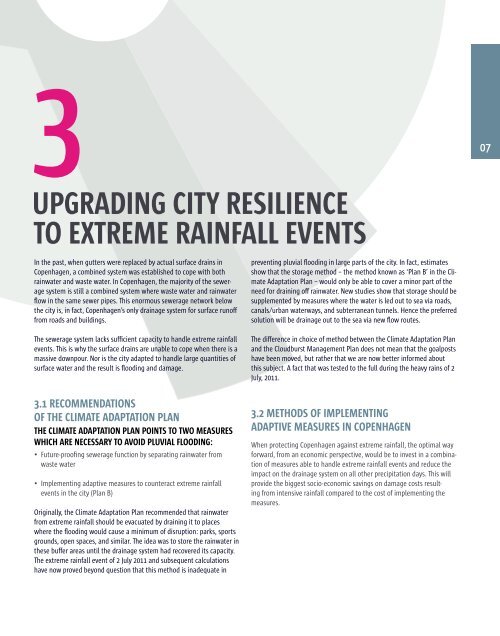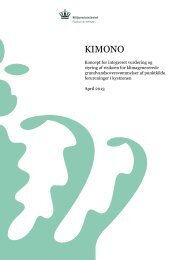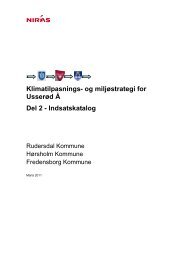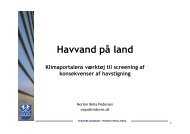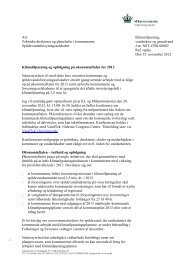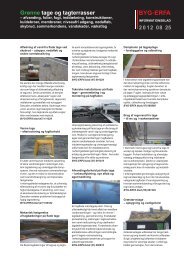Cloudburst Management Plan - Climate Change Adaptation
Cloudburst Management Plan - Climate Change Adaptation
Cloudburst Management Plan - Climate Change Adaptation
You also want an ePaper? Increase the reach of your titles
YUMPU automatically turns print PDFs into web optimized ePapers that Google loves.
3<br />
07<br />
Upgrading City Resilience<br />
to Extreme Rainfall Events<br />
In the past, when gutters were replaced by actual surface drains in<br />
Copenhagen, a combined system was established to cope with both<br />
rainwater and waste water. In Copenhagen, the majority of the sewerage<br />
system is still a combined system where waste water and rainwater<br />
flow in the same sewer pipes. This enormous sewerage network below<br />
the city is, in fact, Copenhagen’s only drainage system for surface runoff<br />
from roads and buildings.<br />
The sewerage system lacks sufficient capacity to handle extreme rainfall<br />
events. This is why the surface drains are unable to cope when there is a<br />
massive downpour. Nor is the city adapted to handle large quantities of<br />
surface water and the result is flooding and damage.<br />
3.1 Recommendations<br />
of the <strong>Climate</strong> <strong>Adaptation</strong> <strong>Plan</strong><br />
The <strong>Climate</strong> <strong>Adaptation</strong> <strong>Plan</strong> points to two measures<br />
which are necessary to avoid pluvial flooding:<br />
• Future-proofing sewerage function by separating rainwater from<br />
waste water<br />
• Implementing adaptive measures to counteract extreme rainfall<br />
events in the city (<strong>Plan</strong> B)<br />
Originally, the <strong>Climate</strong> <strong>Adaptation</strong> <strong>Plan</strong> recommended that rainwater<br />
from extreme rainfall should be evacuated by draining it to places<br />
where the flooding would cause a minimum of disruption: parks, sports<br />
grounds, open spaces, and similar. The idea was to store the rainwater in<br />
these buffer areas until the drainage system had recovered its capacity.<br />
The extreme rainfall event of 2 July 2011 and subsequent calculations<br />
have now proved beyond question that this method is inadequate in<br />
preventing pluvial flooding in large parts of the city. In fact, estimates<br />
show that the storage method – the method known as ‘<strong>Plan</strong> B’ in the <strong>Climate</strong><br />
<strong>Adaptation</strong> <strong>Plan</strong> – would only be able to cover a minor part of the<br />
need for draining off rainwater. New studies show that storage should be<br />
supplemented by measures where the water is led out to sea via roads,<br />
canals/urban waterways, and subterranean tunnels. Hence the preferred<br />
solution will be drainage out to the sea via new flow routes.<br />
The difference in choice of method between the <strong>Climate</strong> <strong>Adaptation</strong> <strong>Plan</strong><br />
and the <strong>Cloudburst</strong> <strong>Management</strong> <strong>Plan</strong> does not mean that the goalposts<br />
have been moved, but rather that we are now better informed about<br />
this subject. A fact that was tested to the full during the heavy rains of 2<br />
July, 2011.<br />
3.2 Methods of Implementing<br />
Adaptive Measures in Copenhagen<br />
When protecting Copenhagen against extreme rainfall, the optimal way<br />
forward, from an economic perspective, would be to invest in a combination<br />
of measures able to handle extreme rainfall events and reduce the<br />
impact on the drainage system on all other precipitation days. This will<br />
provide the biggest socio-economic savings on damage costs resulting<br />
from intensive rainfall compared to the cost of implementing the<br />
measures.


